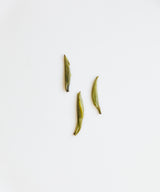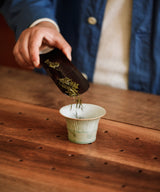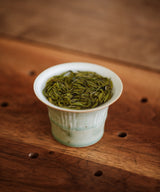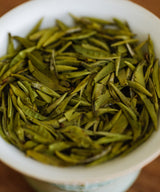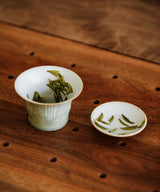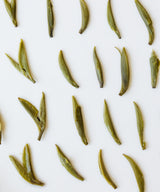Gardenia Bird's Tongue
栀窨雀舌 私房茶
Harvest
June 20, 2025
Origin
Ya’an, Sichuan
A fresh harvest of Gardenia Birds Tongue has arrived. Smelling intensely like cherry blaster candies and sakura, we knew it was going to be a tea for high summer before we even tasted it.
The dense buds with licks of bright silver float on top of the water in the gaiwan. Its pitted fruit and cherry leaf notes taste particularly strong this year, and a juicy acidity draws them out on the finish along with its hints of pandan and pungent, night looming flowers. There is a deep warmth to this tea, and we can appreciate a green tea that conjures so much purple and red in its flavour. By the fourth and fifth infusions a bright, lemony sweetness emerges, a bit like meringue. This is an August tea, if there ever was one.
. . .
A fresh harvest of Gardenia Birds Tongue has arrived. Smelling intensely like cherry blaster candies and sakura, we knew it was going to be a tea for high summer before we even tasted it.
The evocative name “Que She,” which translates to “Bird’s Tongue,” references the tiny, elongated, and tender leaves of this varietal of green tea. The Bird’s Tongue used in this experimental flower tea are First Harvest leaves, picked at the end of March on the sacred Mending Mountains in Ya’an, Sichuan. While all First Harvest teas require careful attention and patience to collect, Bird’s Tongue may be the most meticulous. These sprouts are so small that each serving of tea contains over 300 buds.
We consider this an experimental tea as I had never heard of a gardenia scented tea, let alone a Bird’s Tongue, before this one. It is far more common to scent tea using jasmine or osmanthus flowers, as these flowers can be cultivated on a farm. But gardenias are very delicate and difficult to cultivate – they have to be found in the wild, foraged, and transported quickly to where they can be combined with the tea. To forage enough flowers to do the required number of rounds of scenting is almost unimaginable – making this tea understandably rare, and somewhat of a phenomenon.
The scenting process begins in June, immediately after the wild gardenia flowers bloom in the Mengding Mountains. The flower buds are foraged just before they are about to open, as their scent is lighter and won’t overtake the tea as the mature flowers would. Flower-scenting tea is a time-honoured process that takes roughly two weeks. Gardenia Bird’s Tongue sees seven rounds of scenting. Each round begins just before midnight; a time chosen on behalf of the flowers, as they emit the most compelling fragrance overnight. The green tea leaves are thinly spread out on bamboo mats, where the fresh, wild gardenia buds are then scattered and mixed in with the tea. Left in contact like this overnight, the tea absorbs the aromatic oils from the flowers.
Each scenting cycle mirrors a sleep cycle, lasting eight hours until the following morning. After they have shared in this sleep, the flowers are separated from the tea and the leaves are dried over warm charcoal. The leaves rest for two days, and then another round of scenting begins with freshly foraged flowers. After seven rounds, the Bird’s Tongue is imprinted by its nights with the flowers to the extent that it now carries the gardenia with it.
. . .
Brewing guide
| Tea | 3g |
|
Temperature |
70 °C |
| Water | 120ml |
| Steep time | 5 - 60 sec |
| No. of infusions | 8 |

